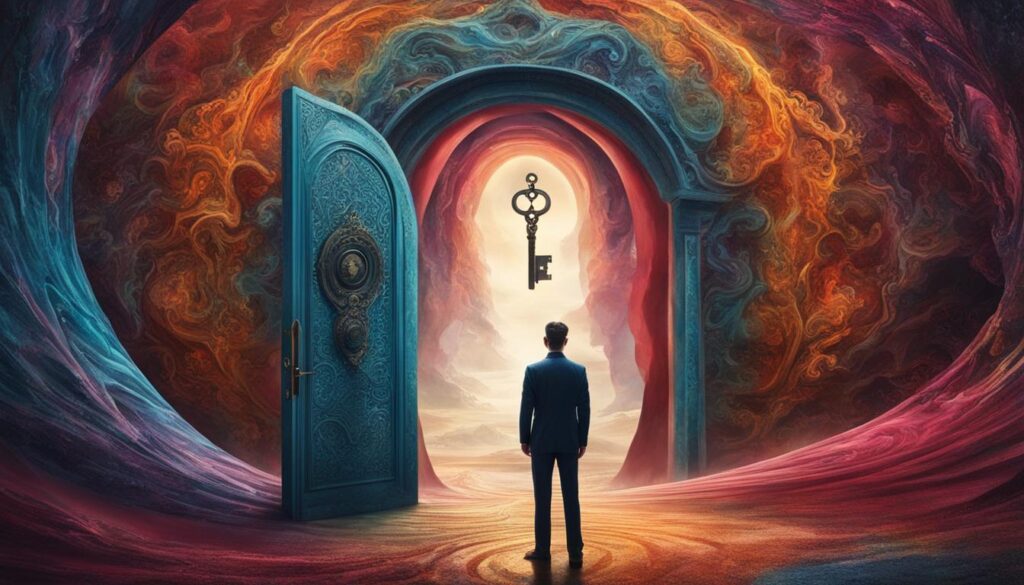Deciphering Dreams in Midlife
Interpreting dreams can provide valuable insights into our subconscious mind. When it comes to understanding dreams in midlife, two frameworks, Freudian Psychoanalysis and the Jungian Approach, offer interesting perspectives. Freudian Psychoanalysis suggests that midlife crisis dreams may represent repressed desires or unresolved issues from earlier stages of life. The Jungian Approach views dreams as a means of self-discovery and self-realization during the midlife stage. By analyzing the symbols, themes, and emotions in these dreams, we can gain a deeper understanding of our own psychological state and uncover hidden meanings.
Key Takeaways:
- Interpreting dreams in midlife can provide valuable insights into our subconscious mind.
- Freudian Psychoanalysis suggests that midlife crisis dreams may represent repressed desires or unresolved issues from earlier stages of life.
- The Jungian Approach views dreams as a means of self-discovery and self-realization during the midlife stage.
- By analyzing the symbols, themes, and emotions in these dreams, we can gain a deeper understanding of our own psychological state.
- Dreams in midlife can uncover hidden meanings and guide us towards personal growth and fulfillment.
Freudian Psychoanalysis for Dream Interpretation
Freudian Psychoanalysis offers a compelling framework for understanding dreams in the context of midlife crisis. According to this approach, dreams serve as a window into our subconscious desires and unresolved issues from earlier stages of life. By analyzing the symbolism and themes in these dreams, we can gain valuable insights into our unfulfilled goals and suppressed aspirations.
Through dream interpretation, we can uncover the hidden messages that our subconscious mind is trying to convey. For example, a dream about being stuck in a high-pressure job may symbolize a deep longing for a more fulfilling career. By understanding the symbolism behind these dreams, we can begin to make changes in our lives that align with our true passions and desires.
The Freudian perspective reminds us that our dreams reflect aspects of ourselves that may have been repressed or overlooked. By exploring the symbols and themes in our dreams, we can gain a deeper understanding of our psychological state and use that knowledge to embark on a journey of personal growth and fulfillment.

Unveiling the hidden meanings
“Dreams are the royal road to the unconscious.” – Sigmund Freud
Freudian Psychoanalysis emphasizes the importance of dream symbolism in understanding our midlife crisis dreams. Symbols in dreams are often representations of our deepest desires and fears, as well as unresolved conflicts. By delving into the symbolism, we can decode the hidden meanings and gain insight into our unfulfilled goals.
Unlocking personal fulfillment
By embracing Freudian Psychoanalysis as a tool for dream interpretation, we can unlock our true potential and pursue personal fulfillment. Understanding the symbolism in our midlife crisis dreams can guide us towards making positive changes in our lives, pursuing our passions, and ultimately finding greater satisfaction and happiness.
Jungian Approach to Dream Analysis
In the realm of dream analysis, the Jungian Approach offers a fascinating perspective on understanding dreams during the midlife stage. This framework emphasizes the connection between our conscious and unconscious realms, viewing dreams as a means of self-integration, personal growth, and self-realization. By delving into the symbols, themes, and emotions within these dreams, we can gain valuable insights into our deepest desires, frustrations, and aspirations.
According to Carl Jung, dreams serve as a vehicle for exploring different possibilities and embracing our creativity. They provide an opportunity for self-exploration and guide us on a journey of discovering our authentic selves. In the context of a midlife crisis dream, this approach highlights the dreamer’s yearning for personal growth and self-discovery.
By paying attention to the messages and symbols in our dreams, we can uncover hidden aspects of ourselves that are seeking expression and transformation. Dreams become a powerful tool for gaining a deeper understanding of who we are and what we truly desire, ultimately guiding us towards a more fulfilled and purposeful life.
Key Points:
- The Jungian Approach to dream analysis emphasizes self-integration, personal growth, and self-realization.
- Dreams provide an opportunity for self-exploration and discovering our authentic selves.
- By analyzing the symbols, themes, and emotions in our dreams, we can gain valuable insights and guide our personal growth.

Example Quote:
“Dreams are the guiding words of the soul. Why should I learn to listen to my dreams? Because within them is hidden the gate to eternity.” – Carl Jung
Dream Symbolism in Midlife Crisis Dreams
Midlife crisis dreams often contain symbols that can provide valuable insights into our subconscious mind, guiding us on a path of self-discovery and personal growth. These symbols hold hidden meanings that can help us navigate the challenges and transitions that arise during this transformative stage of life.
In a midlife crisis dream, the symbolism of certain elements can be particularly significant. For example, a recurring theme of feeling lost or aimless may be represented by a never-ending road. This symbolizes the dreamer’s dissatisfaction with their current life path and their yearning for a more fulfilling direction.
“Dreams are the royal road to the unconscious.” – Sigmund Freud
Examining the symbols in our dreams can reveal repressed desires or unfulfilled goals that may be driving our discontent in midlife. By analyzing these symbols and their corresponding emotions, we can gain a deeper understanding of our own psychological state and uncover hidden aspirations.
Unlocking the Power of Dream Symbolism
- Pay attention to recurring symbols or themes in your dreams, as they often carry significant meaning.
- Keep a dream journal to record your dreams and reflect on their symbolism.
- Explore the emotions and feelings associated with the symbols in your dreams to gain further insights into your subconscious mind.
- Consider seeking the guidance of a professional dream analyst or therapist to help decipher the symbolism in your dreams.
By delving into the world of dream symbolism, we can gain a deeper understanding of ourselves and use this newfound knowledge to navigate the complexities of the midlife crisis. Dreams become powerful tools for self-discovery, personal growth, and ultimately, leading a more fulfilling and purposeful life.
Midlife Crisis: Navigating Life Transitions with Self-Exploration and Personal Growth
Midlife crisis is a transformative stage that many individuals experience between the ages of 35 and 50. It is a period marked by significant life transitions and a deep yearning for self-exploration and personal growth. While often associated with negative connotations, midlife crisis can actually serve as an opportunity for self-reflection, reevaluation of priorities, and embracing new directions for a more fulfilling life.
During this stage, individuals may find themselves questioning their current path, feeling dissatisfied with their accomplishments, or craving a deeper sense of purpose. It is a time to pause, take stock of one’s life, and explore new possibilities. Self-exploration becomes a powerful tool for understanding one’s desires, values, and aspirations, enabling individuals to make conscious choices that align with their authentic selves.
Personal growth is a natural outcome of the midlife crisis journey. It involves embracing change, stepping outside of one’s comfort zone, and challenging limiting beliefs. Through self-reflection, individuals can identify areas for improvement, cultivate new skills, and develop a more resilient mindset. With personal growth comes a greater sense of self-confidence, fulfillment, and overall well-being.
The Characteristics of Midlife
Midlife is a stage of life characterized by various conditions and emotions. It is not uncommon to feel a sense of dissatisfaction with our current life during this time. We may question the choices we have made and wonder if there is more to life than what we have experienced so far. This dissatisfaction can serve as a catalyst for self-reflection and a desire for change.
A sense of disorientation is also a common experience in midlife. We may find ourselves questioning our identity and our place in the world. The roles and responsibilities that once defined us may no longer feel fulfilling, leading to a period of exploration and self-discovery as we search for new meaning and purpose.
“Midlife is a time when we become acutely aware of our limitations. Our bodies may start showing signs of aging, such as wrinkles and a decrease in energy levels. We may also face the reality that some of our dreams and aspirations may not come to fruition.”
Biological changes also become more apparent during midlife. Our bodies go through hormonal adjustments, and we may experience physical changes that remind us of our mortality. While these changes can be challenging, they also provide an opportunity for us to embrace our humanness and gain a deeper understanding of ourselves.
Dissatisfaction, disorientation, awareness of limitations, and biological changes are all common characteristics of midlife. While they may present challenges, they also offer opportunities for personal growth, reflection, and a deeper understanding of ourselves.

Dreams and the Midlife Crisis
In the midst of a midlife crisis, dreams become a gateway to the unconscious, offering a realm of exploration and self-discovery. As we navigate this transformative stage of life, our dreams provide valuable insights into the hidden aspects of ourselves that have remained dormant for years.
Unconscious exploration is an integral part of the midlife journey, and dreams serve as guideposts along the way. They have the power to reveal deep-seated desires, unresolved issues, and untapped potentials. By paying attention to the symbols, emotions, and narratives within our dreams, we can unravel the layers of our psyche and gain a clearer understanding of our authentic self.
Self-discovery is at the heart of the midlife crisis experience, and dreams act as a mirror reflecting our innermost thoughts, fears, and aspirations. They help us confront the questions we may have been avoiding: Who am I? What do I truly want in life? What legacy do I want to leave behind?

Unleashing the Power of Dreams
In order to fully tap into the potential of dreams during this phase, it is essential to engage in dreamwork. This can involve keeping a dream journal by our bedside, recording our dreams as soon as we wake up, and exploring their meanings through various techniques such as symbolism analysis, dream interpretation books, or working with a qualified therapist.
By harnessing the wisdom embedded within our dreams, we open ourselves up to new possibilities and avenues for personal growth. They provide guidance and direction during a period of uncertainty and confusion, helping us navigate the uncharted territories of the midlife crisis with greater clarity and purpose.
Embracing the Journey
The midlife crisis can be a challenging and yet transformative phase of life. By embracing the messages that dreams bring us, we can embark on a journey of self-discovery, exploration, and personal transformation. Dreams serve as a powerful tool to guide us towards a more harmonious and fulfilling life, as we uncover the hidden treasures within ourselves and find our true purpose.
Embracing Spiritual Growth and Creativity
As I navigate the midlife crisis, I believe it is essential to embrace spiritual growth and tap into my creativity. This stage of life presents a unique opportunity to explore my life’s purpose and unleash my creative potential. By engaging in dreamwork and deciphering the messages from my subconscious mind, I can gain valuable insights that guide me on this transformative journey.
Spiritual growth is a powerful tool for self-reflection and personal development. It allows me to connect with something greater than myself and find meaning in my experiences. By nurturing my spirituality, whether through meditation, prayer, or introspection, I can cultivate a deeper understanding of my purpose and navigate the challenges of midlife with greater clarity and resilience.
Creativity, too, plays a vital role in this stage of life. It is through creative expression that I can tap into my authentic self and explore new possibilities. Whether it’s painting, writing, or engaging in any other form of artistic expression, creativity allows me to channel my emotions, thoughts, and dreams into something tangible. It is a pathway to self-discovery and a means of connecting with others on a deeper level.
Dreamwork is an integral part of this journey. Dreams provide me with valuable insights into my subconscious mind and offer guidance on my path towards personal growth. By analyzing the symbols, themes, and emotions in my dreams, I can uncover hidden meanings and gain a deeper understanding of myself. Dreams serve as a bridge between the conscious and unconscious realms, and by embracing dreamwork, I can harness their transformative power.







